Not until after the war were some of the perpetrators of the Novemberpogrom 1938 in Innsbruck arrested and sentenced by the people´s court at the national court of Innsbruck.
In August 1946 Anton Haupt was sentenced to 6 years, Richard Dietrich and Alfred Gnesetti to 3 years in consequence of the excesses against the families Brüll und Diamand.
In October 1946 Hans Aichinger was sentenced to 13 years and Gottfried Andreaus to 12 years in prison, both had been engaged in the assassinations of Richard Graubart and Wilhelm Bauer.
Hans Aichinger was born in 1913 as son of an innkeeper family in Innsbruck. He attended the international college of hotel management in Vienna. He was a skiing instructor and together with his brother-in-law he managed the ski schools in St. Anton and St. Christoph/ Arlberg. On August 5th, 1932 he joined the NSDAP and the SS, where he was promoted to the rank of an SS-Hauptsturmführer and bearer of the ring of skull and crossbones. There were many convinced National Socialists in his family like his father, his brother, his cousin and his brother–in-law. In April 1940 he married Herta Nissl, daughter of Richard Nissl, an owner of a brewery and a castle in Innsbruck. A few weeks after the sentence regarding his accompliceship in the pogrom night he fled to Argentina via Bozen, where he worked as a skiing instructor in San Carlos de Bariloche. In 1957 his prison sentence was reduced to three years. In 1959 he returned to Austria, where he gave himself up to the police and in 1961, after an amnesty, he was released from prison. He died in 1972 at the age of 59.
In November 1946 engineer Heinrich Huber was sentenced to 5 years, Otto Mohr to 3 years, Alfons Ullmann and Johann Schöpf to 2,5 years, Georg Weintraut to 15 months and Josef Girardi to 18 months. This perpetrator group assaulted and badly hurt members of the families Josef Adler and Flora Bauer . Further, they demolished the domiciles of the families Adler, Schwarz, Spindel and Bauer.
In 1947 Josef Ebner was sentenced to 1,5 years, August Hörhager and Alois Hochrainer to 2 years, Hans Riedl to 14 months, Karl Handl to 20 months, Hans Bayer to 14 months and Hermann Moser to 6 months. They deployed the gang against the families Schindler, Löwensohn, Schwarz, Schenkel, Meisel and Diamand.
In October 1947 Theodor Haller was sentenced to 6 years for throwing the married couple Popper into the river Sill.
Rudolf Schwarz (SS) and Robert Huttig ranked among the group of perpetrators against the families of Richard Graubart and Wilhelm Bauer. In December 1947 they were sentenced to 11 and 10 years. Both were paroled and were released from custody in November 1951.
In August 1948 Johann Mathoi (SA) was sentenced to 3,5 years in prison and Rudolf Mayerbrucker (NSKK) to 2,5 years. Both were proved guilty of passing on of the instructions for the pogrom during the roll call of the members of the SA- and NSKK at Bürgerstrasse 10. Besides, Mathoi was brought to account for the destruction of dwellings of the families Dubksy and Fuchs.
In December 1948 the chief of the Gestapo Werner Hilliges, a native of Berlin, was sentenced to life imprisonment with hard labour during the “Innsbrucker Reichenau trial ” because of crimes against the humanity and the assassination of Egon Dubsky in the labour camp Reichenau on June 2nd, 1943 . On December 3rd, 1955, he was paroled and released from custody. Together with his wife he committed suicide in 1956.
In September 1950 Gauhauptstellenleiter Walter Hopfgartner was condemned to 3 years, afterwards to 10 years because of maltreatment and high treason. He had been son of a master butcher and member of the NSDAP since his eighteenth year. Under the Christmas amnesty he was put on parole in December 1954.
SS-Oberscharführer Dr. Robert Duy came from Upper Austria, studied medicine in Innsbruck from 1934 to 1938, was an early member of the NSDAP, and a member of the frat Suevia. He was married to a woman from Lower Austria and had four children. In March 1946, he was arrested and held in pretrial detention at the district court in Amstetten (Lower Autria) for his involvement in the murder of Richard Berger. After a brief escape attempt, he turned himself in to the police in June 1946 and remained in custody until July 7, 1946. He was officially taken to the USSR by the Russian military command and did not return to Germany until the spring of 1954 after being released from custody. In reality, he lived under a false name as a “U-boat” in southern Germany until the early 1950s. From 1956, he ran his own medical practice under his real name in Hessen. In 1974, his true identity was uncovered in a dragnet investigation, and he was arrested. After only a few days, he was released on bail and allowed to continue working as a doctor. In 1975, the trial against him was dropped due to lack of evidence after 37 years had passed. He died from a brain tumor in late December 1975. (Gundel Rath-Duy)(II)
After the repeal of war criminal law Walter Sauerwein reported to the public prosecution in February 1958. His proceedings were stopped in December 1958. Before that he worked as an architect in Köln-Braunfeld.
Franz Hofer
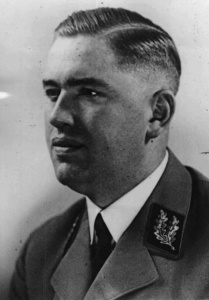 Gauleiter Franz Hofer was born on November 27th, 1902 in Bad Hofgastein. He attended school in Innsbruck, became a merchant and had been a member of the NSDAP since 1931. On November 27th, 1932 he was promoted to Gauleiter of Tyrol and Vorarlberg. After the ban of NSDAP he was arrested in June 1933 and in August of the same year he was forcibly freed by SA men. Until the Anschluss he lived in Germany and acquired German citizenship. From May 24th, 1938 to May 3rd, 1945 he was Gauleiter of Tyrol and Vorarlberg, NSKK-Obergruppenführer (senior-group-leader) and Reichsstatthalter (“imperial lieutenant”) of Tyrol-Vorarlberg. After his arrest by the US-Army on May 3rd, 1945 he escaped to Germany in October 1948. He was condemned to ten years labour camp with forfeiture of property by a Munich court. He accumulated a fortune, among other things a villa of the Jewish family Schindler at Rennweg 10 in Innsbruck (today´s Institute for biomedical research into ageing of the Austrian Academy of Siences) and the Lachhof in Kleinvolderberg near Hall in Tyrol. In August 1952 the punishment was lowered to three years and five months. An Austrian court sentenced Hofer to death in absentia in 1950, but the sentence was never carried out. The then governor of Tyrol, Alfons Weißgatterer, is said to have supported Hofer’s case. Hofer lived in Mülheim an der Ruhr with his wife and seven children, continued his former trade as a salesman and died a natural death on February 18th, 1975, under his real name. In 1964 an Austrian court dismissed a lawsuit put forth by the children of Hofer for the return of the Lachhof. (1) (a)
Gauleiter Franz Hofer was born on November 27th, 1902 in Bad Hofgastein. He attended school in Innsbruck, became a merchant and had been a member of the NSDAP since 1931. On November 27th, 1932 he was promoted to Gauleiter of Tyrol and Vorarlberg. After the ban of NSDAP he was arrested in June 1933 and in August of the same year he was forcibly freed by SA men. Until the Anschluss he lived in Germany and acquired German citizenship. From May 24th, 1938 to May 3rd, 1945 he was Gauleiter of Tyrol and Vorarlberg, NSKK-Obergruppenführer (senior-group-leader) and Reichsstatthalter (“imperial lieutenant”) of Tyrol-Vorarlberg. After his arrest by the US-Army on May 3rd, 1945 he escaped to Germany in October 1948. He was condemned to ten years labour camp with forfeiture of property by a Munich court. He accumulated a fortune, among other things a villa of the Jewish family Schindler at Rennweg 10 in Innsbruck (today´s Institute for biomedical research into ageing of the Austrian Academy of Siences) and the Lachhof in Kleinvolderberg near Hall in Tyrol. In August 1952 the punishment was lowered to three years and five months. An Austrian court sentenced Hofer to death in absentia in 1950, but the sentence was never carried out. The then governor of Tyrol, Alfons Weißgatterer, is said to have supported Hofer’s case. Hofer lived in Mülheim an der Ruhr with his wife and seven children, continued his former trade as a salesman and died a natural death on February 18th, 1975, under his real name. In 1964 an Austrian court dismissed a lawsuit put forth by the children of Hofer for the return of the Lachhof. (1) (a)
Villa Schindler, Rennweg 10:

Lach-Hof, Kleinvolderberg:


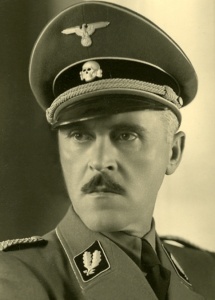
Johann Feil
SS-Oberführer Johann Feil – the real commander of the pogrom – was a native Upper-Austrian, NSDAP-member since 1932 and a high-ranking SS-officer till the end of war. He fled to Argentina assisted by Catholic bishop Alois Hudal, a native citizen of Graz and died in Mittenwald / Garmisch-Partenkirchen in Germany in 1956. (b)
Bishop Alois Hudal had been principal of the Collegio Teutonico di Santa Maria dell´Anima (German National Church) in Rome since 1923 and thus the supreme priest for the German expatriates. The college of priests and the Papal Ancillary Commission for Refugees (Assistenza Austriaca), which was founded by Hudal, were situated in Via della Pace 20 and this is where many National Socialist refugees found shelter. Hudal helped them to get valid passports and thus enabled their escape to South America.
Erwin Fleiss
Erwin Fleiss was an SS-Sturmbannführer, born on January 16, 1910, in Innsbruck. He was a commercial employee, joined the NSDAP and SS in 1930, enlisted in the military in January 1942, and was a high-ranking lieutenant until the end of the war. He was married and had three children, receiving several promotions, including the Cross of Honor 2nd Class. In 1948, with Vatican assistance, he fled to Paraguay and then to Argentina, where SS-Hauptsturmführer Horst Carlos Fuldner gave him a profitable job as a travel agency manager in his “Argentine Society for Industrial Projects and Their Implementation – Fuldner & Co,” also known as CAPRI. Erwin Fleiss was also amnestied in 1957 following an NS punishment decree. He died on October 11, 1964, in Cipolleti, Río Negro. (II)
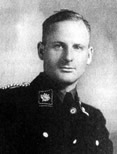 Leopold Spann
Leopold Spann
Dr. Leopold Spann, an Oberregierungsrat and SS-Obersturmbannführer, was born on December 20, 1908, in “Bayerbach-Bayern-Deutsches-Reich” and studied law. He joined the NSDAP in 1932 and led the Gestapo Innsbruck between 1939 and 1940, as well as the Gestapo office in Saarbrücken between 1943 and 1944, where on March 29, 1944, he murdered two British flyers in custody, Roger Bushell and Bernhard Scheidhauer, outside Ramstein. He was also involved in the mass murder of Jews in the Ukrainian district of Nikolayev in 1942-1943. From July 1944 to April 1945, he was the Gestapo chief in Linz, where he was killed in an air raid on April 25, 1945. (2a, 2b, 2c) (c)(II)
Adolf Franzelin
Dr. Adolf Franzelin was born on August 8, 1892, in Innsbruck and completed a sports degree. He was an enthusiastic football player and a member of the “FC Wacker Innsbruck”. He was an SS-Untersturmführer and until his death in 1940, he was the head of the Innsbruck police headquarters. After the assassination of the commander of the municipal security guard, Franz Hickl, on July 25, 1934, in the Herrengasse in Innsbruck, he was accused of involvement, but the court could not prove his active participation. He died on April 25, 1940, in Innsbruck. (Gruber) (II)
Vinzenz Waidacher
SA-Standartenführer Vinzenz Waidacher was born on July 19, 1900, in Mieders and was a trained mechanic. He was one of the pioneers of the NSDAP movement in Innsbruck, having been a member of the NSDAP since 1932 and a close confidant of Gauleiter Franz Hofer. He delivered speeches at the annual commemorative events of the “Höttinger Saalschlacht” on May 27, 1932. From 1935 until his death in 1941, he was the top leader of the SA in the Tirol-Vorarlberg region. He was one of the main organizers during the November Pogrom in Innsbruck (Hagen). During World War II, he was stationed in Poland and Norway. Waidacher fell in a skirmish with Soviet troops on September 11, 1941. Josef Eduard Ploner, a member of the Arbeitsgemeinschaft Tiroler Komponisten during the NS period, dedicated his Fanfare No. 14 to him. (II)
Hermann Duxneuner
The Aryanization commissioner Hermann Duxneuner was born on July 4, 1909 in Innsbruck. His father, Dr. Hermann Duxneuner, was a lawyer and from 1901 to 1924 the first managing director of the Tyrolean National Mortgage Bank. As a member of the Nazi Party (since 1933) and SS (since 1936), he was responsible for the “de-Judaization” or “Aryanization” of the Jewish merchant class in the “National Socialist Trade and Commerce Organization” (NS-Hago). Based on a “Jewish list” prepared by him, the rolling squads proceeded against the Jewish families and their businesses on the night of the pogrom. “Interim administrators” were appointed through his Aryanization office, among others for the furniture company Brüll, the vinegar and spirits factory Dubsky, the company Alois Hermann, the Schöneck pension in Seefeld, and Dr. Paul Kühne’s farm in Pfaffenhofen. Together with former district main office leader Rudolf Ullrich and coal dealer SS Rottenführer Alois Mössmer, he acquired a property in Höttingerau in Innsbruck. His wife, Ernestine Frank, came from Mieders in Stubaital and worked as a secretary in the Aryanization office since 1939. During the war, he served in the SS Panzer Regiment 3. Following the war, he hid with SS comrades in South Tyrol, obtained a passport from the International Red Cross with the help of the Papal Emergency Relief Service, and traveled to Argentina unrestricted. From July 1978 and April 1979, the Duxneuner couple were registered again in the municipality of Mieming in Tyrol, where Hermann died on July 15, 1982, and Erna on November 9, 1982. Together with their son Hermann, who died in 1979, they are buried in Barwies. (Meixner, Steinacher) (II)
Alois Schintlholzer
 SS-Sturmbannführer Alois Schintlholzer, native of Innsbruck, notorious pugilist and member of the German gymnastics association and of the NSDAP since 1932 was condemned to life imprisonment in absence twice by Italian law in consequence of contribution in a retaliation of the Waffen-SS, in which the village Caviola was burned to the ground and 40 humans were murdered. Schintlholzer, who was also involved in the abduction and arrest of Merano’s Jews in September 1943, managed to evade arrest twice and lived in Bielefeld, Germany, under his own name. In 1950, he participated in the escape of SS-Obersturmbannführer Adolf Eichmann to Argentina. After voluntarily surrendering to the court in Innsbruck, he was held in custody from April 1961 to March 1962 until the case was dismissed. He died in June 1989 and was buried in Innsbruck. Two announcements of death were published in the Tiroler Tageszeitung by the Kameradschaft IV, Tirol, and Mathilde Schintlholzer’s widow, which transformed the Waffen-SS’s motto “His Honor Was Loyalty” into a new version. His daughter Birgit Schintlholzer-Barrows dissociated herself from this. Photos of the funeral in Pradl can be seen on Markus Wilhelm’s website dietiwag.org . (3a, 3b, 3c, 3d, 3e) (d) (II)
SS-Sturmbannführer Alois Schintlholzer, native of Innsbruck, notorious pugilist and member of the German gymnastics association and of the NSDAP since 1932 was condemned to life imprisonment in absence twice by Italian law in consequence of contribution in a retaliation of the Waffen-SS, in which the village Caviola was burned to the ground and 40 humans were murdered. Schintlholzer, who was also involved in the abduction and arrest of Merano’s Jews in September 1943, managed to evade arrest twice and lived in Bielefeld, Germany, under his own name. In 1950, he participated in the escape of SS-Obersturmbannführer Adolf Eichmann to Argentina. After voluntarily surrendering to the court in Innsbruck, he was held in custody from April 1961 to March 1962 until the case was dismissed. He died in June 1989 and was buried in Innsbruck. Two announcements of death were published in the Tiroler Tageszeitung by the Kameradschaft IV, Tirol, and Mathilde Schintlholzer’s widow, which transformed the Waffen-SS’s motto “His Honor Was Loyalty” into a new version. His daughter Birgit Schintlholzer-Barrows dissociated herself from this. Photos of the funeral in Pradl can be seen on Markus Wilhelm’s website dietiwag.org . (3a, 3b, 3c, 3d, 3e) (d) (II)
Gerhard Lausegger
Gerhard Lausegger was an SS-Student Storm Leader born in Klagenfurt in 1915. He studied law in Innsbruck, was a member and spokesman of the frat Suevia, chairman of the dueling associations in Innsbruck, chief of the security executive, and adjutant of the 87th SS-Standarte. He was arrested in Carinthia by members of the British military in 1945, and in May 1946, he was discovered by the son of the murdered Richard Berger – Frederik R. Benson. In March 1947, he fled through South Tyrol to Argentina using an International Red Cross passport, where he died in an accident on December 20, 1966, under the name Nicolo Gracea. Since then, his name has been honored at the Innsbruck Westfriedhof at the memorial of the German-national frat Suevia – in close proximity to the Jewish cemetery. In November 2015, the city of Innsbruck erected a memorial stele for Richard Berger next to the Suevia memorial. (II)
Gerhard Lausegger and Frederik R. Benson © DOEW (e)
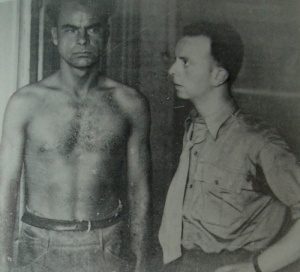
Memorial of the German-national frat Suevia:
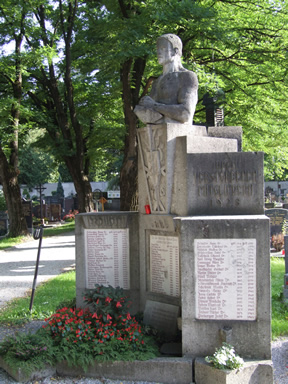
![]()
Memorial stele for Richard Berger:
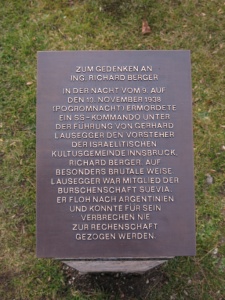
Wilhelm Harster
SS-Gruppenführer and lieutenant-general Dr. Wilhelm Harster, born in 1904 in Kehlheim in Bavaria, finished a law degree in Munich, joined the NSDAP in May 1933 and had been a member of the SS since August 1934. From March 1938 he built up the Gestapo in Innsbruck and was leader of the State Police Reginal Office until November 1939. In July 1940 he became Commander of the Security Police and SD in Netherlands and from August 1943 to May 1945 he was Commander in Verona, Italy. In March 1949 he was sentenced to 12 years imprisonment by a Dutch court in The Hague and released from prison in 1953. In 1956 he became a Civil servant (first Regierungsrat, eventually Oberregierungsrat) in the Bavarian Ministry of the Interior. After the imprisonment of SS-Hauptsturmführer Erich Rajakovic, a former collaborator of Harster in 1963, civil servant Dr. Wilhelm Harster had to retire and was arrested in 1966. Finally, in February 1967 a German court in Munich sentenced him to 15 years for organizing and participating in the deportation and complicity in the murder of Italian and Dutch Jews , among them Anne Frank. After two years in prison he was paroled. He died in Munich in December 25, 1991. (4, 5, 6) (f)
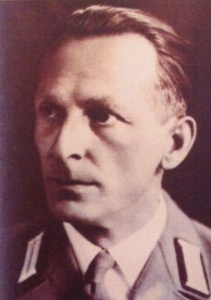 Egon Denz
Egon Denz
Dr. Egon Denz was a native of Vorarlberg who studied law at the University of Innsbruck and was an early member of the NSDAP (since 1933), SS-Standartenführer, deputy of the unofficial Gauleiter of the NSDAP of Tirol-Vorarlberg Edmund Christoph, Gauamtsleiter for communal policy, and from March 12, 1938 until May 1945 mayor of Innsbruck. After the war, preliminary investigations were initiated, but the proceedings of the People’s Court in Innsbruck were discontinued, and Egon Denz was released from custody in October 1947. He died on December 15, 1979, and was buried in an honorary grave at the Westfriedhof cemetery in Innsbruck. (8) (g)
Gottfried Andreas
Gottfried Andreaus, born in Innsbruck in 1912, became a member of the NSDAP and the SS in 1933 and returned home as a war invalid in 1940, where he became an active resistance fighter in 1944. He helped to track down the surviving perpetrators of the “Kristallnacht” and was paroled in 1951. (II)
Johann Aichinger
Johann (Hans) Aichinger was born on December 27, 1913, the son of the Innsbruck innkeepers of the “Goldener Hirsch.” He attended the Higher International Hotel School in Vienna, was a skiing instructor, and led the ski school in St. Anton and St. Christoph am Arlberg in the winter of 1938/39 together with his brother-in-law Hubert Salcher. He was an actor in adventure and mountain films. On August 5, 1932, he joined the NSDAP and the SS, rising to the rank of SS-Hauptsturmführer and was in possession of the Death’s Head Ring. There were several convinced National Socialists with party or SS membership in the family, including his father, brother, cousin, and the aforementioned brother-in-law. In April 1940, he married Herta Nissl, daughter of Richard Nissl, an Innsbruck brewery and castle owner. A few weeks after the verdict for complicity in the pogrom and illegal Nazi activities, he fled to Argentina with the help of the Lantschner brothers via Bolzano, where he worked as a skiing instructor in the winter sports resort of San Carlos de Bariloche. In 1957, his prison sentence was reduced to three years, and in 1959, he returned to Austria, surrendered to the authorities, and was released after being pardoned in 1961. He died on June 5, 1972, at the age of 59. (II)
Jako Strickner und Friedrich Lantschner
SS-Sturmbannführer Jakob Strickner and Friedrich (Fritz) Lantschner were also actively involved in the atrocities of the Pogrom Night.
Jakob Strickner was a farmer and innkeeper in Vinaders am Brenner, a member and co-founder of the Tyrolean NSDAP, an SS officer, and a profiteer of “Aryanizations.” After his release from captivity in 1947, he assisted the South Tyrolean Adolf Steiner in the escape of the concentration camp doctor Josef Mengele. In 1949, Mengele fled to Argentina together with Adolf Eichmann and Goebbels’ employee Ernst Müller with newly issued passports from the International Red Cross. Strickner himself was the mayor of Gries am Brenner for twenty-four years and proud of his assistance to Mengele’s escape.
Friedrich (Fritz) Lantschner was a high-ranking illegal member of the NSDAP, provisional director of the Tyrolean Chamber of Agriculture, government director of the department “Agriculture, Economy, Labor,” and district leader for agricultural policy in Tyrol. As a district deputy of the illegal NSDAP, he ordered the murder of the commander of the municipal security guard, Franz Hickl, on July 25, 1934. After the end of the Nazi regime, he fled to San Carlos de Bariloche in Argentina along with his brother Gustav “Guzzi” Lantschner, a filmmaker and successful ski racer of the 1930s, under the protection of Bishop Alois Hudal, where they met with numerous former SS comrades, including Johann Aichinger. (II)
Ferdinand Obenfeldner
As Gestapo agent Ferdinand Obenfeldner was involved in the capture of badly injured Richard Schwarz and his 16 year-old son Viktor in Falkstrasse 19. He grew up in Innsbruck and finished a commercial apprenticeship. In 1934 he became a member of the “Revolutionary Socialists”, in 1939 he joined the NSDAP and SS. During the war years he served in the 5th Gebirgsdivision of the Wehrmacht. After war captivity he returned to Innsbruck in August 1945. Within the denazification he was paroled as a “lesser offender” in August 13th, 1947. Afterwards he began his political career as a Socialist Party member in the local council Innsbruck as well as in the Tyrolean Landtag. He was director of the Tyrolean Health Insurance (TGKK) and vice-mayor of Innsbruck for 23 years. (7)
update 30.10.2023
Translation:
Gerhard Buzas
(II) Translated by OpenAI’s ChatGPT
Literature:
Martin Achrainer < Zum Umgang mit den NationalsozialistInnen in Tirol nach 1945 > in: Verein zur Förderung justizgeschichtlicher Forschungen und Verein zur Erforschung nationalsozialistischer Gewaltverbrechen und ihrer Aufarbeitung (Hg.), “Justiz und Erinnerung Nr.10”, Mai 2005, S 11-14
Thomas Albrich (Hg.), “Die Täter des Judenpogroms 1938 in Innsbruck”, Haymon Verlag Innsbruck-Wien 2016
Thomas Albrich / Michael Guggenberger < “Nur selten steht einer dieser Novemberverbrecher vor Gericht” – Die strafrechtliche Verfolgung der Täter der so genannten “Reichskristallnacht” in Österreich, Holocaust und Kriegsverbrechen vor Gericht – Der Fall Österreich > StudienVerlag 2006, S 26-56
Thomas Albrich < Ing. Robert Schüller: "Ich war, bin und bleibe ein Nationalsozialist" > in: Wir lebten wie sie… – Jüdische Lebensgeschichten aus Tirol und Vorarlberg, Haymon Verlag 1999
Christoph W. Bauer < Graubart Boulevard > Haymon Verlag Innsbruck-Wien 2008
Christoph W. Bauer < Im Alphabet der Häuser - Roman einer Stadt > Haymon Verlag Innsbruck-Wien 2007, S 263-297
Nikolaus Bliem < SS-Hauptsturmführer Johann (Hans) Aichinger > in: Thomas Albrich (Hg.), “Die Täter des Judenpogroms 1938 in Innsbruck”, Haymon Verlag Innsbruck-Wien 2016, S 58-63
Johannes Breit < Das Arbeitserziehungslager Innsbruck-Reichenau und die Nachkriegsjustiz > Maturafachbereichsarbeit Juni 2007, S 41, 48-50
Burgl Czeitschner / Hubertus Czernin / Ernst Schmiederer < Einige Sekunden blieb alles still / Novemberpogrom in der “Ostmark”, seine Täter, ihre Opfer > in: Profil Nr. 45, 7. November 1988, S 62 ff
Ina Friedmann < "Man könnte direkt zweifeln, ob der Frager oder die Befragte schwachsinnig ist!" Zwangssterlisierungen und Zwangskastrationen im Gau Tirol-Vorarlberg unter besonderer Berücksichtigung der Beteiligung der Universität Innsbruck > Endbericht des Forschungsprojekts: “Unfruchtbarmachung” und “freiwillige Entmannung”. Die Innsbrucker Universitäts-Kliniken und die Erbgesundheitsgeschichte des Reichsgaues Tirol und Vorarlberg, 2020
Michael Gehler < Murder on Command – The Anti-Jewish Pogrom in Innsbruck – 9th-10th November 1938 > in: Year Book XXXVIII, Leo Baeck Institute. 1993, S. 119-153
Carina Gruber < SS-Untersturmführer Dr. Adolf Franzelin > in: Thomas Albrich (Hg.) < Die Täter des Judenpogroms 1938 in Innsbruck > Haymon Verlag Innsbruck-Wien 2016, S 38-42
Nikolaus Hagen < SA-Brigadeführer Vinzenz Waidacher > in: Thomas Albrich (Hg.) < Die Täter des Judenpogroms 1938 in Innsbruck > Haymon Verlag Innsbruck-Wien 2016, S 31-36
Andreas Hauser < Die Akte Hofer: “Ich bleibe Nationalsozialist” > in: Echo 07-08/2008, S 66
Gretl Köfler < Die “Reichskristallnacht” > in: Dokumentationsarchiv des österreichischen Widerstandes (Hg.) – Widerstand und Verfolgung in Tirol 1934 bis 1945 – Österreichischer Bundesverlag Wien 1984, Band 1, S 448-462
Herbert Lackner < Die Hakenkreuzfahrer > in: profil 33, 11.08.2008, S 28-35
Christian Mathies < "Immer auf der Seite der Demokratie?" - Überlegungen zur Kontroverse um die NS-Vergangenheit von Ferdinand Obenfeldners > in: Gaismair-Jahrbuch 2008 – Auf der Spur, StudienVerlag 2007, S 42-50
Wolfgang Meixner < “Arisierung” – die “Entjudung” der Wirtschaft im Gau Tirol-Vorarlberg, Tirol und Vorarlberg in der NS-Zeit > StudienVerlag 2002, S 319-340
Sonja Niederbrunner < “Das Gefühl der Schuld wird mich begleiten”, Er war Leiter der Gestapo in Innsbruck, ein hochrangiger Nazi in den Niederlanden und in Italien – und Oberregierungsrat im bayerischen Innenministerium. Wilhelm Harster stand zwei Mal vor Gericht – er bereute. > in: Echo Nr.101, Ausgabe 11/2007, S. 48-49
Horst Schreiber < "Werner Hilliges: Leiter der Gestapo Innsbruck" > in: Nationalsozialismus und Faschismus in Tirol und Südtirol – Opfer . Täter . Gegner, Tiroler Studien zu Geschichte und Politik, Michael-Gaismair-Gesellschaft, StudienVerlag 2008, S 207-208
Horst Schreiber < Franz Hofer: Gauleiter und Reichsstatthalter von Tirol-Vorarlberg > in: Nationalsozialismus und Faschismus in Tirol und Südtirol – Opfer . Täter . Gegner, Tiroler Studien zu Geschichte und Politik, Michael-Gaismair-Gesellschaft, StudienVerlag 2008, S 86-88
Gad Hugo Bella < Die Juden Tirols – Ihr Leben und Schicksal > Israel 1979
Gerald Steinacher < Nazis auf der Flucht – Wie Kriegsverbrecher über Italien nach Übersee entkamen > StudienVerlag 2008, S 39 ff, 50, 78-80, 171, 265 ff , 291, 296
Picture credits:
(a) Hofer – http://data.onb.ac.at/rec/baa1252636
(b) Feil -Private ownership © Wolfgang Feil
(c) Spann – http://www.flugzeugabstuerze-saarland.de/Bushell_Scheidhauer.pdf
(d) Schintlholzer – profil Nr. 45 – 7. November 1988, S 73
(e) Lausegger – DOEW
(f) Harster – http://forum.axishistory.com/viewtopic.php?t=1629
(g) Denz – Ausstellung “Stadtplanung und Architektur der 30er Jahre” Archiv für Baukunst, Universität Innsbruck
Reference:
(1) Neueste Zeitung 1938, Nr. 257, Freitag 11.11.1938, 26. Jg. – Stadtarchiv Innsbruck
(2a) http://www.historyinfilm.com/escape/real9.htm
(2b) http://forum.axishistory.com/viewtopic.php?f=38&t=151833
(2c) Information über den Tatort von Silvano Wueschner – Email 1.7.2015
(3a) http://www.schnitzler-aachen.de/Surftipps/2000_06.htm
(3b) http://www.breit.biz/sites/bertbreit_ns.html
(3c) Triumph der Gerechtigkeit, Flucht von Adolf Eichmann – http://www.spiegel.de/spiegel/print/d-77745555.html – visit 27.08.2012
(3d) http://dietiwag.org/blog/index.php?datum=2013-11-06 – visit 16.11.2013
(3e) Email Birgit Schintlholzer-Barrows – 26.01.2021
(4) Christian Ritz – http://historiker-in-muenchen.com/pageID_4835828.html
(5) http://www.cine-holocaust.de/cgi-bin/gdq?efw00fbw002552.gd
(7) Wolfgang Neugebaur, Peter Schwarz (Hg.) < Der Wille zum aufrechten Gang - Offenlegung der Rolle des BSA bei der gesellschaftlichen Reintegration ehemaliger Nationalsozialisten > Czernin Verlag Wien 2005, S. 151-160
(8) Wikipedia – http://de.wikipedia.org/wiki/Egon_Denz – visit 30.10.2012
(9) Mail correspondence with Gundel Rath-Duy, daughter of Robert Duy 07-10/2023
Wikipedia – http://de.wikipedia.org/wiki/Johann_Feil
http://de.wikipedia.org/wiki/Franz_Hickl – visit 04.11.2012
Wolfgang Meixner – Email vom 02.11.2008 – Hermann Duxneuner – Der Historiker Wolfgang Meixner hat mich auf biografische Daten von Hermann Duxneuner aufmerksam gemacht, welche er bereits in seinem Aufsatz < "Arisierung" - die "Entjudung" der Wirtschaft im Gau Tirol-Vorarlberg, in: Rolf Steininger, Sabine Pitscheider (Hg.), "Tirol und Vorarlberg in der NS-Zeit", StudienVerlag 2002, S 319-340 >erforscht hat. Für diesen Hinweis bin ich ihm zu Dank verpflichtet.
Tiroler Tageszeitung 1946, Nr. 237 – S 3, Nr. 238 – S 5 – Tiroler Landesmuseum Ferdinandeum
Tiroler Neue Zeitung 1946, Nr. 202 – S 3 – Tiroler Landesmuseum Ferdinandeum
Tiroler Tageszeitung 1990, Nr. 151, S 4 – Tiroler Landesmuseum Ferdinandeum
Der Standard 1990, Nr. 493, S 5 – Tiroler Landesmuseum Ferdinandeum

